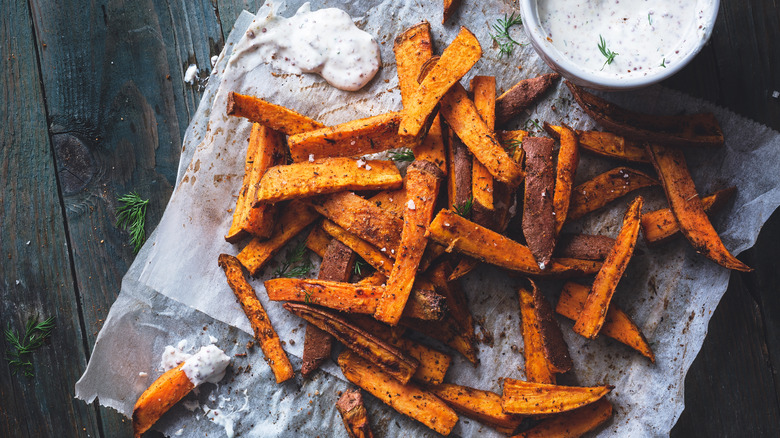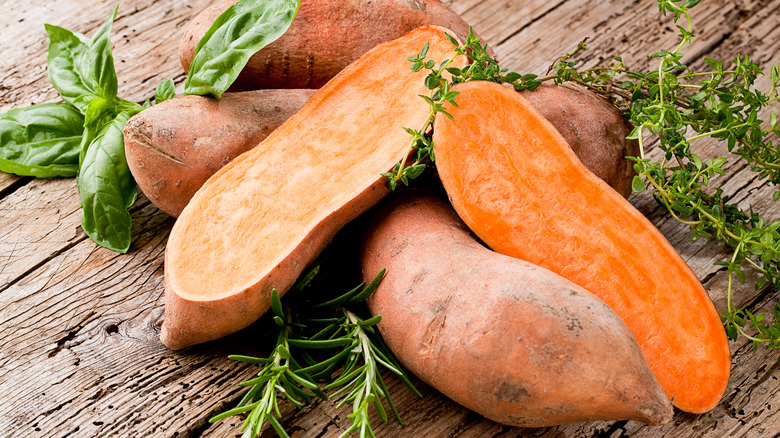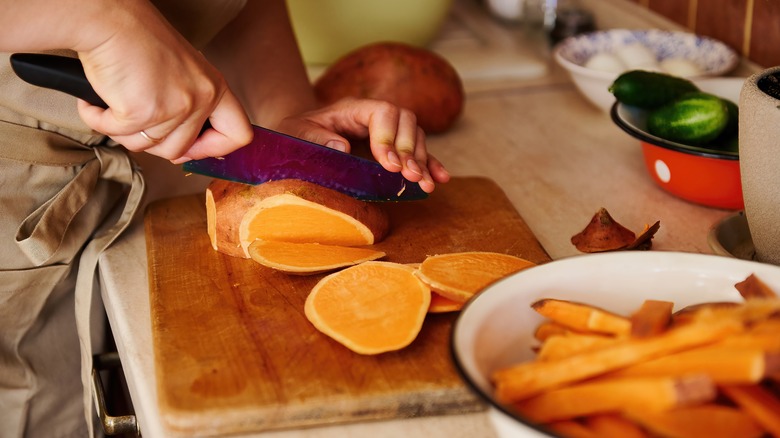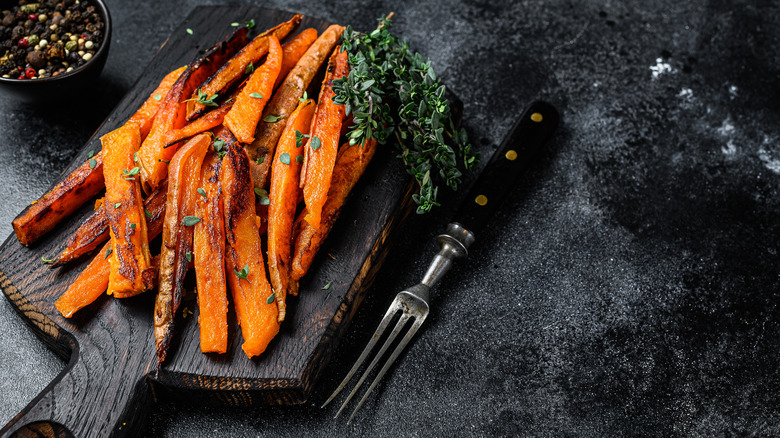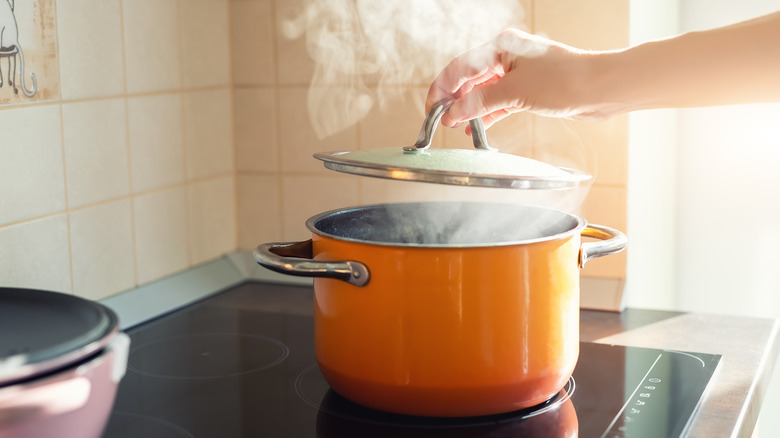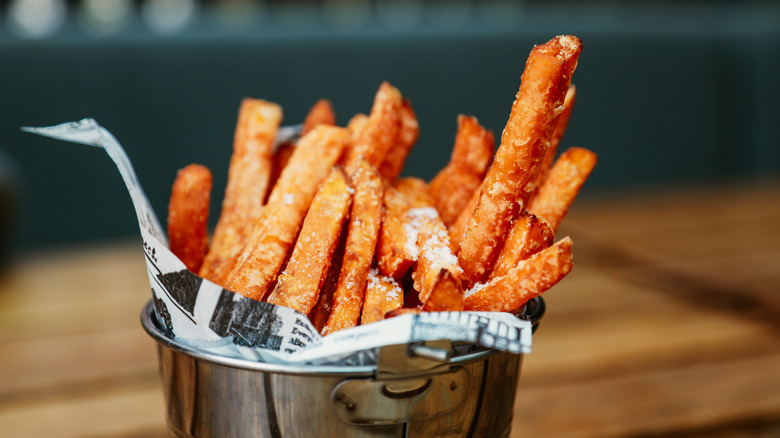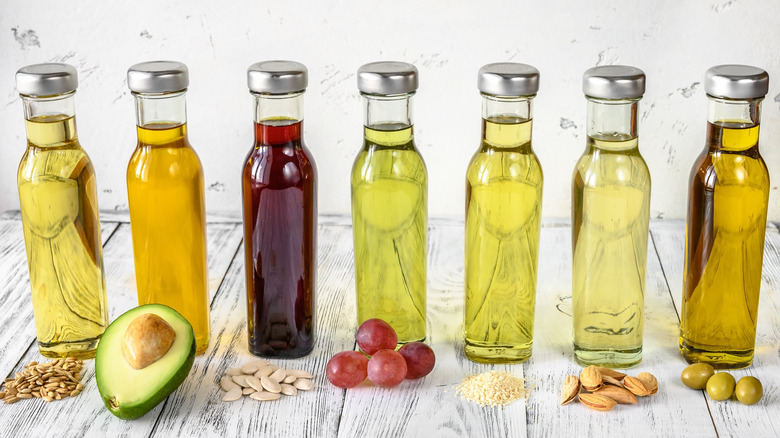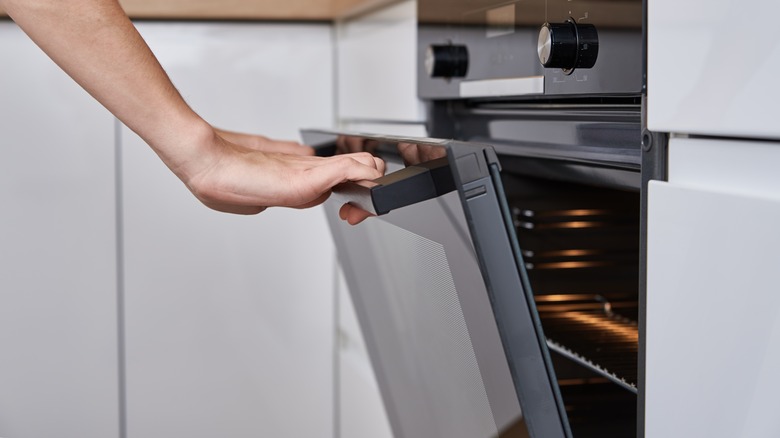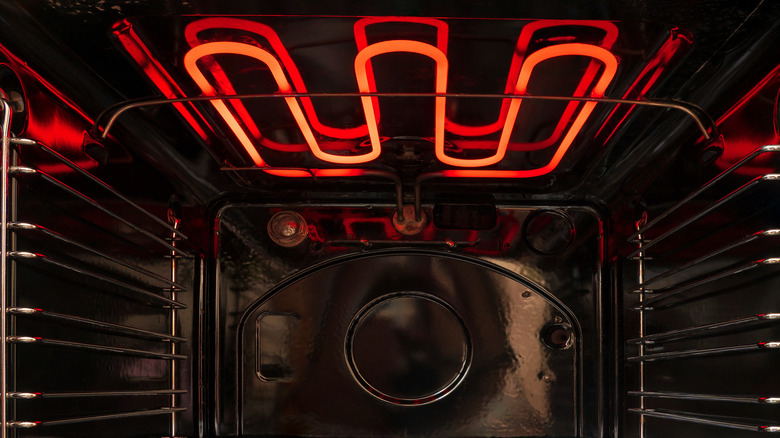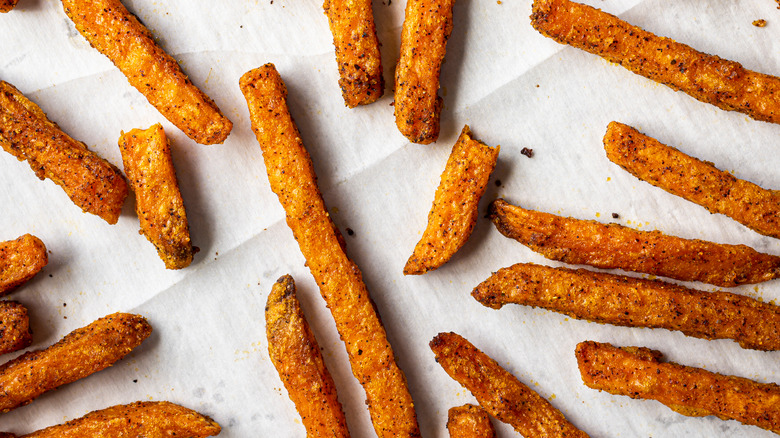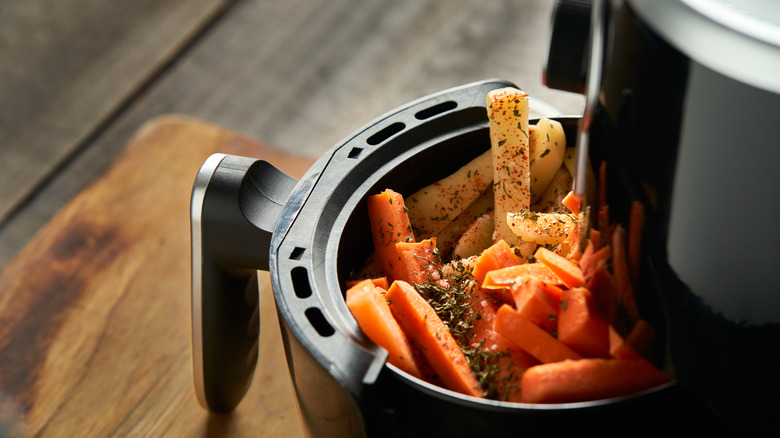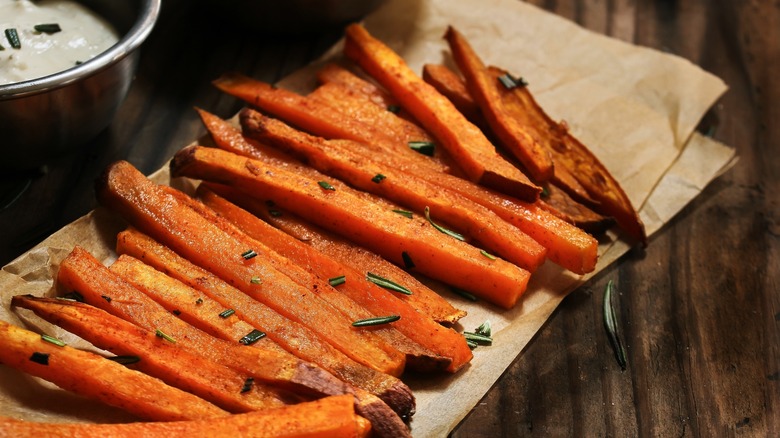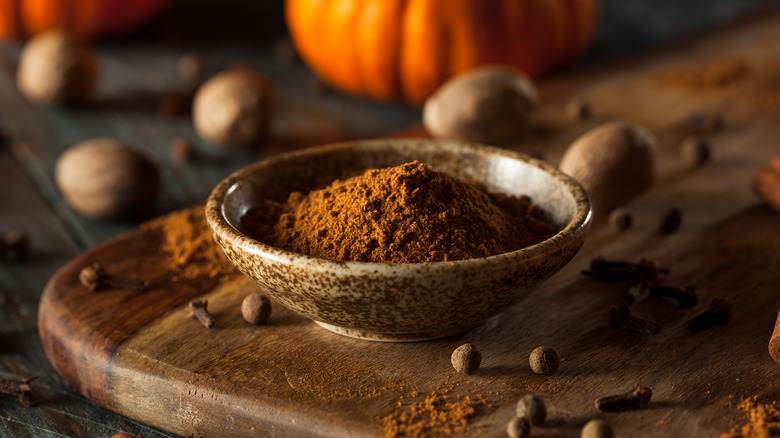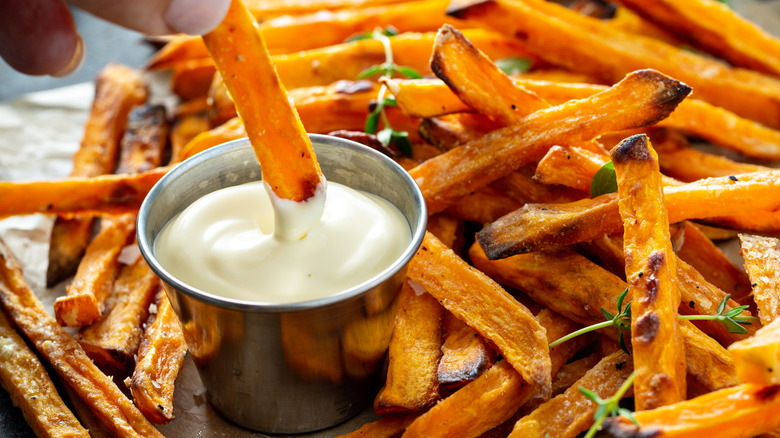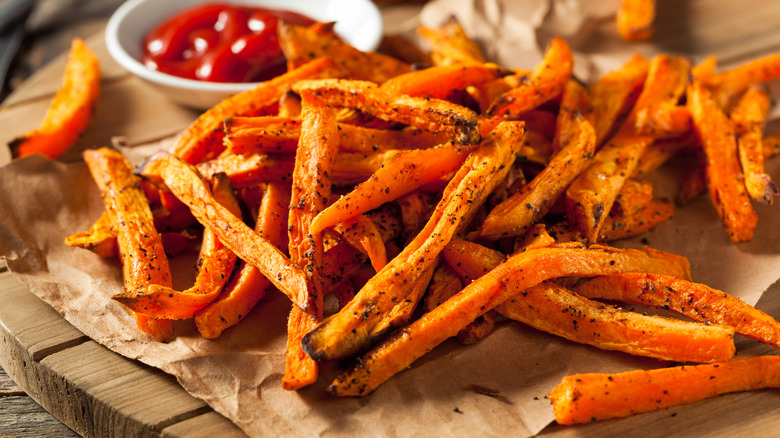14 Tips You Need For Perfect Sweet Potato Fries Every Time
For those of you who seek out menus with the option to substitute your plain old french fries with the far superior sweet potato alternative, this article is for you. Sweet potato die-hard fans know these baked or fried tubers outshine basic fries in flavor and versatility. They can be dressed up as savory or sweet and taste exceptional with a range of spices and dipping sauces.
Don't wait until your next dinner at a restaurant to experience your favorite side dish. Instead, follow these tips for perfect sweet potato fries every time, made right in the comfort of your home. While the cooking process may seem as simple as chopping up the tuber, tossing it in oil, and popping the pieces in the oven, a little extra legwork in the preparation process can make a world of difference. Stick to these top tips, and enjoy crispy, flavorful, can't-get-enough sweet potato fries.
Select the right sweet potatoes
While some people refer to them as yams, the orange tubers we know and love are, in fact, not actually part of the yam family. That said, you may find them nestled between the white potatoes and yams at the grocery store, though there are different varieties to pick from. Japanese sweet potatoes are purple, starchy, and quite delicious, while white sweet tubers are drier and extra sweet. Grab a few different options to bake and experiment with later, though when making sweet potato fries, it's best to stick to the bright orange assortment we are used to. They tend to have a richer moisture content and are easier and more familiar to cook with.
Remember, not all sweet potatoes are created equal. Anyone who cooks with produce frequently knows that several determining factors can change a dish's outcome. These include where the fruit or vegetable is grown, how long ago it was picked, and how ripe it is. Select a healthy sweet potato: The firmer, the better. Look for smooth skin that's not flaking. Smaller tubers tend to have a sweeter flavor, so in this case, bigger isn't always better.
Cut even slices
Who doesn't love indulging in a serving of fries? Each bite is juicy, tender, and of course, crispy — but not always. Typically, by the end of the basket, the scattered rejected remains of burnt crispy ends lie and wait for their inevitable doom of plummeting head first into the waste bin along with wadded-up napkins and bottle caps. These bits are a result of fries sliced too small that cooked at a faster rate than their friends. So, to avoid making this mistake, take your sweet time cutting your tuber up to ensure every piece is equally delicious.
Grab a cutting board and a sharp knife. Sweet potatoes are quite tough, so take your time and tuck your fingers in to keep them safe. Your goal is to cut long, french fry-sized slices. If you prefer potato wedges, cut them into thick pieces, but remember that you will end up with slightly less crunchy fries than those cut into thinner portions, which may be preferable to your palate.
Don't peel them
Name a more tedious task than peeling potatoes: We'll wait. And sweet potatoes are even worse because they are so much tougher. However, the skins themselves are quite desirable; they're loaded with nutrients and fiber, so throwing them down the garbage disposal would be a shame. Instead, skip the peeling process altogether and leave them on. A little varied texture now and again never hurt anyone, and potato skins are known to crisp up nicely in the oven, air fryer, or deep fryer. That said, be sure to cut off any rough patches, knobs, or eyes that look like they would be tough to chew on.
In addition, sweet potato fries with skins have that brewery-style, rustic aesthetic that foodies just can't get enough of. Serve them on a toasted piece of parchment paper with flakey salt, coarsely ground black pepper, with some kind of fancy aioli, and you could charge a pretty penny for them.
Parboil them first if you're going to bake them
Although we all love our one-pot recipes, slow cookers, and instant meals, sometimes taking a few extra steps in the kitchen makes it all worthwhile. Ever grab a handful of homemade baked sweet potato fries and notice that they are rubbery or chewy instead of fluffy and crispy? This can happen because the insides aren't quite cooked enough, but the outsides are beginning to dry out. Don't worry, sweet tuber lovers; there is a solution! This tip is a need-to-know to get the crispiest potato fries ever.
Start by cutting your root vegetable into wedges or thin strips, then quickly parboiling them. Boil water with a little baking soda to make it alkaline; use about half a teaspoon of the ingredient per two cups of water. This will help the exterior of the tuber break down more and draw the starches to the surface. When this is later coated with oil and interacts with heat, it will create a crispy layer of starch that will give you that irresistible crunch. Just be sure to remove the sweet potatoes from the boiling water after just a few minutes. They should keep their form when removed and patted dry.
Coat them in cornstarch
When it comes to fries, the crispier, the better. It's important to get the texture just right, or else you're really just eating roasted sweet potatoes cut into matchsticks, which might taste great, but it's certainly no french fry. To get that ultimate crunchy layer on the outside, only found on fries that bubble and flake, consider using one special ingredient that you should use for all roasted vegetables: Coat your chopped and parboiled sweet potatoes in oil, and then cornstarch. This addition creates a layer of starchy goodness on the outside of the fry, and when it comes in contact with the oil and the heat, it bubbles to golden perfection.
Baking sweet potato fries may never give you that oily crunch that deep frying has, but the cornstarch will get you one step closer without the health risks. Go one step further to add flavor by mixing your coating with seasonings that will enhance your side. Garlic powder, dried parsley, paprika, and black pepper are classics, but feel free to experiment with others.
Choose your fat carefully
Oven-baked or air fryer sweet potato fries don't just crisp up on their own; a little oil goes a long way. A tuber coated in the ingredient will become much crispier than one just sliced and tossed under heat. This is because oil increases the surface temperature of the potato and helps it dry out, which gives it that famous crunch.
For low-temperature roasting, consider using olive oil. Consider using animal fat, butter, or a high-heat-safe oil for high temperatures, which is likely what you'll be doing for fries. Animal fat will give your fries an extra element of depth and flavor. However, if you're trying to reduce your cholesterol intake or stick to a vegetarian diet, look for peanut, avocado, canola, vegetable, or safflower oils. All of these are safe for high cooking temperatures.
When it comes to taste, avoid strong varieties like coconut or sesame oils unless your recipe calls for it or you're intentionally flavoring your fries. When in doubt, stick to vegetable oil and let that sweet potato flavor shine.
Use a top oven rack
When it comes to making the perfect sweet potato fries, sometimes it pays to get a little particular with the cooking process — even something as small as your oven rack position. If you plan on baking your tubers, ensure they are placed in the top third of the oven. It's best to set the rack in place before turning the appliance on so you don't have to mess with piping-hot metal or allow heat to escape while you shift things around.
Next, preheat the oven along with your baking sheet. This will ensure that your sweet potato strips get to crisping as soon as possible once that door is shut, with as little of an adjustment period as possible. Then, line your pan with parchment paper and space out your fries enough on top so they can get proper air circulation and don't overlap or touch. This will ensure the tubers won't burn on the bottom before the tops can crisp up. That said, it's still important to flip or toss them around halfway through cooking. An evenly cooked fry is much more enjoyable than one with burnt ends or soggy sides.
Cook at a high heat
Oven-roasted veggies certainly have a different overall texture than those that have been deep-fried, no matter how many tips and tricks you adhere to. Even if you can't reach that fried state, a high-temperature oven can get you pretty darn close. This will ensure the inside is steamed to perfection while the outside gets that added crunch and crispiness.
Start by setting your oven to at least 425 degrees Fahrenheit, although you can go as high as 450. It's important to preheat the stove first because otherwise, your orange tubers will dry out as they slowly come to temperature. Think of a deep fryer; food gets plunged in without any time to warm up first, and we want to mimic that process as closely as possible.
When cooking at such high temperatures, it's important to always be cautious when opening the oven and handling the baking pan. Always stand back from the stove when it's first open to allow any steam to release and wear protective gear such as oven mitts when preparing to touch anything hot.
Spread them out
Vegetables have a high H2O content, making them moist, healthy, and delicious. Although sweet potatoes may not have the same amount as cucumber or celery, they are made up of 77% water. This may seem surprising as they are quite solid, but if you've ever handled a dried-up sweet potato that has long expired, you'll notice it's quite lightweight because it's no longer retaining its moisture. This means that vegetables tend to steam while cooked as their water content is released. To avoid soggy sweet potato fries, take precautions by laying them on your baking sheet in a certain configuration.
Space out those orange tuber slices. If they are touching or overlapping, they will release their moisture into one another instead of allowing their outer layer to dry out and get crispy. They don't have to be in uniform rows, but arrange them so they have space to breathe. In the same vein, only use one baking sheet at a time. This will ensure your fries are the only recipients of the oven's heat and that you're getting proper air circulation.
Use an air fryer
Why are people so obsessed with their air fryers? They talk about them like they are their children in this day and age. Well, if you own this appliance, you already know the answer: It's because this seemingly magical device allows us to eat what tastes like fried food daily without the additional health risks.
Air fryers work similarly to a convection oven; they circulate high-temperature air around a basket that holds the food. Instead of taking 30 to 40 minutes to make french fries in the stove, it could take just a little more than 15 minutes total with this smaller appliance. Plus, the result of its hot air produces food that is shockingly similar to the deep-fried version.
The process is quite simple; follow a crispy air fryer sweet potato fries recipe or just add your oil-coated chopped tubers to the device, let it rip, and give it a little toss about halfway through the cooking process.
Season them
Yes, sweet potatoes are loaded with natural flavor and taste quite good once cooked. There's a reason baked tubers are often eaten plain or seasoned with just a little salt. That said, there's always room for more, and these root vegetables are the queens of versatility when it comes to spicing. Because they have so much natural sugar, they can skew both sweet and savory.
There are countless ways to add more flavor to sweet potatoes, but a safe way to start your seasoning adventure is by mixing garlic powder and black pepper. Try paprika, cinnamon, ginger, cumin, and pepper for a colorful Moroccan spice blend. If you want to recreate a fancy restaurant favorite, opt for garlic powder, rosemary, and pepper. A parmesan, garlic powder, and parsley combination is always a top hit, and who doesn't like cheese?
Whatever flavor scheme you go with, remember that it's essential to season fries with salt and toss them after removing them from the heat source. This will ensure that moisture isn't drawn to the surface while cooking, which would create soggy and rubbery tubers.
Sweeten them up
Sweet potatoes are true to their name; they are loaded with natural sugars that caramelize once they come in contact with heat. The flavor almost mimics that of cooked carrots or even pumpkins.
Pumpkin spice lovers will be happy to hear that this unique seasonal blend doesn't have to be limited to autumn; load up your sweet potato fries with the mix. For a simpler topper, try using plain old cinnamon. Sprinkle the sweet potatoes with sugar before baking to create a super-carmelized outer layer with an extra crispy crunch. When it comes to the dipping sauce, go sweet or go home. Try a cinnamon sugar dipping sauce with a butter base or a maple chili alternative. Go one step further and break out a jar of fluff and dip your fry into marshmallowy goodness. Hey, if this doesn't get your kids (or yourself) to load up on vegetables, then we don't know what will.
Always serve with a dipping sauce
When it comes to any savory dish, we can all agree that the saucier, the better. Everything tastes good with a dip, and even though sweet potatoes are chock full of fantastic flavor, the fries deserve to be accompanied by a condiment. While ketchup complements the average white potato fry perfectly, sweet tubers deserve something a little more unique.
Because of their sweet and savory status, you have a range of possibilities when it comes to the accompaniments. Mix hot and sweet flavors to make honey mustard, maple barbecue, or Thai peanut sauce. Go savory with varied aiolis like garlic and lemon, parsley and pickle, or chipotle. Tahini dips make an incredible condiment for paprika and garlic-spiced sweet potato fries. Green goddess dressing, made with endless herbs blended into a creamy sauce, is unforgettable when paired with the roasted orange tuber. Lastly, sriracha mayo, chipotle lime, and curried ketchup are simple to make and can take your sweet potato fries to the next level.
Allow them to rest
How often have you burnt the roof of your mouth on a bubbling slice of cheese pizza, a juicy fried pickle, or a basket of fresh french fries? While it's tempting to dig right in, we also know that good things take time, and keeping those taste buds intact for what's about to come might be worthwhile. There is, however, another reason to let your sweet potato fries sit for a few minutes after they come out of the oven or air fryer.
Allowing them to rest will ensure your safety and let them finish cooking. Any additional moisture is released as the oil cools and the tubers stop steaming from within. This is a great opportunity to season them with salt or any other after-baking spice you'd like. Don't wait too long, though. Be sure to enjoy your side after they've sat for no more than five minutes and before they cool down to room temperature. Everyone likes food hot out of the oven, so try to time your dish to come out last while the rest of your meal is coming together. Then, time to dig in, dipping sauce and all.
